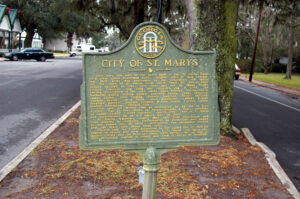To further examine this year’s Georgia History Festival theme, “From Marshes to Mountains, Georgia’s Changing Landscape: Geography, History, and Community,” this week’s #MarkerMonday highlights the City of St. Marys marker in Camden County. The City of St. Marys, incorporated on November 26, 1802, is the southernmost coastal city in Georgia, located close to the Georgia-Florida state line. During the years prior to and following its establishment, the city of St. Marys played a significant role, owing to its connection to the Spanish in Florida and as a Georgia coastal town.
In the sixteenth century, the Spanish in Florida established a series of religious and military outposts in Georgia and South Carolina. These establishments served as a foothold for the development of Spanish missions along the Georgia coast in the seventeenth century. Near the mouth of the St. Marys River, Santa Maria, a Spanish mission from Florida, was organized. The mission most likely served as a school for Native American boys in the area. Although the history of the name of the town is unclear, some claim that St. Marys was named after this mission.
The Spanish missions in Georgia were eventually abandoned in the late seventeenth century due partly to a decline in Native American populations from disease, forced resettlements, and pirate raids. After its abandonment by the Spanish, the Georgia coast was resettled by English colonizers. Under the English crown, the land of St. Marys was originally owned by two brothers of royal governor James Wright, but their banishment following the American Revolution left the land under the ownership of state legislator Jacob Weed. In 1787, the town of St. Marys was purchased by twenty proprietors from Jacob Weed for $38. Following its official incorporation in 1802, St. Marys has been of considerable importance as a Georgia coastal town. In 1815, during the Battle of Fort Peter, the British successfully captured the town of St. Marys and Fort Peter. As a port of entry controlled by Confederate forces, the town’s waterfront buildings were bombarded with shells from the United States Navy during the Civil War.. St. Marys has since served as a major area of tourism, and it is known as the “The Gateway to Cumberland Island.”
Explore the links below to learn more:
New Georgia Encyclopedia – St. Marys
GHS houses a collection related to the City of St. Marys:
Isaac F. Arnow aricles on the history of St. Marys and Camden County, Georgia
The Georgia Historical Quarterly has published several articles relating to the City of St. Marys, which can be accessed on JSTOR. If your library does not have access to JSTOR, you can go to www.jstor.org and create a free MyJSTOR Account.
Johnson, J. G. “THE SPANISH SOUTHEAST IN THE SEVENTEENTH CENTURY.” The Georgia Historical Quarterly 16, no. 1 (1932): 17–26. http://www.jstor.org/stable/40576161.
Floyd, Joseph. “Ghosts of Guale: Sugar Houses, Spanish Missions, and the Struggle for Georgia’s Colonial Heritage.” The Georgia Historical Quarterly 97, no. 4 (2013): 387–410. http://www.jstor.org/stable/24636327.

